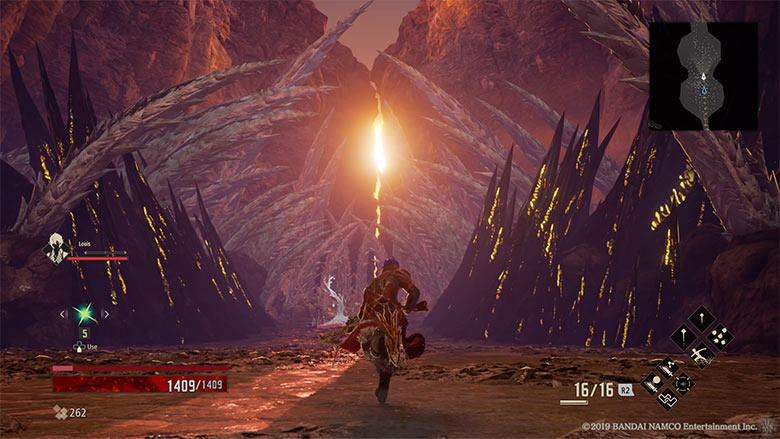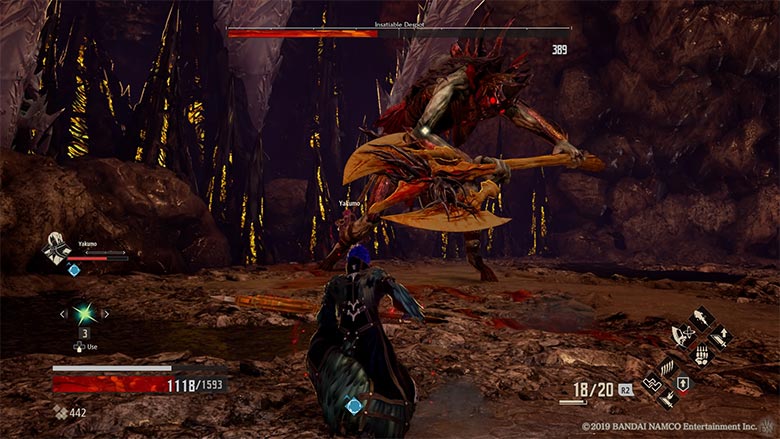
Screenshot by Jack Fennimore
Note: Code for PS4 version provided by publisher.
I’m having a great time with Code Vein. Unfortunately I didn’t have enough time to get through enough of the game for a full review in time for when reviews come out, so here’s my impressions of the game from what I’ve played so far.
Code Vein wears its Dark Souls influence on its sleeve. You live in a dying world ravaged by a great calamity and play as a Revenant, a vampire, essentially. They have to drink blood or else risk becoming a mindless monster known as the Lost (in other words, they go Hollow). Bloodbeads, blood-filled fruit that grows on trees, are the best way to get blood, but they’re in short supply and Revenants are fighting each other for them. You must work with your new Revenant friends to figure out how to grow a renewable supply of Bloodbeads so you can put an end to the constant fighting and misery in the world. You explore the world collecting Haze (Souls) to level up at a Mistle plant (Bonfire) and learn new Gifts (Spells and Miracles).
However, Code Vein differs quite a lot from Dark Souls in a number of ways that not only make the game unique from its inspiration, but also add more convenience for the player.
You know how in Dark Souls you pick a starting class with different weapons and distributions of stats? Imagine if those classes can be equipped to your character like an armor piece. You just imagined something close to the Blood Codes.

Screenshot by Jack Fennimore
Blood Codes let you change your build on the fly, modifying your stats for different approaches to combat. Some codes will increase your attack strength and defense at the cost of magic power and dexterity while some codes do the opposite. Different Blood Codes also grant you access to different Gifts, abilities that range from buffs to offensive spells. If you use the Blood Code long enough while fighting enemies, you can inherit Gifts and use them with other Blood Codes (so long as you have the right stat requirements).
This replaces crafting your own build by increasing each stat point by point every time you level up. Leveling up now raises most of your stats across the board. Some may miss the unique nuances of build building in Dark Souls and the anticipation of working toward a stat requirement for a cool weapon, but now you can respec any time you want with no strings attached. So if you are struggling with a boss or group of enemies, or if you’re simply growing tired of your current build, you can change your build to suit your needs. The different Gifts also gives you a ton of extra flexibility, offering many opportunities to craft some unique builds. You can be a ranged fighter that uses poison or a fighter that uses ranged spells in addition to heavy weapons.
The combat has a wonderful sense of fluidity to it. Your light, heavy and special attacks as well as your dodges flow really nicely between each other. They also work wonderfully with your Gifts, and you should be using them often since you’re constantly draining Ichor – mana or magic points – from the enemy and can even use a Drain Attack (or parry an attack or us a backstab) to raise how much Ichor you can store. There’s a ton of different combos you can use to really wreck your foes. However, your foes are just as ferocious, so you need to come at combat smartly and with confidence. That being said, I think the stamina bar is more of a obligation to make it feel more Souls-like than a backbone to the combat as it often gets in the way of your attacks.

Screenshot by Jack Fennimore
But the biggest thing Code Vein brings to the Souls-like formula is a partner character. Any time you’re out on the field, you can bring another Revenant with you on your travels. You can have either a computer-controlled companion or a real-life friend through an online connection.
I was worried that the partner would make the many of the fights trivial, as is often the case when engaging in jolly cooperation in Dark Souls. But that’s definitely not the case here.
Your AI friends are very intelligent. They never rush into battle recklessly; in fact, you’ll probably be the one rushing into battle. When you’re close to death, they can add more health to your character at the cost of their own so long as they have enough Ichor and health – and you can do the same. The enemies are balanced really nicely so that they still pose a challenge even though there are two people fighting them. Often they have their own Gifts that boost you along with themselves. It really does feel like your working together as a team. You can let your AI partner distract an enemy while you charge up a Drain attack to raise your Ichor cap.
The partnerships you make mesh really well with the themes of trust and cooperation found throughout the game’s story. You really get to know and fall in love with your companions, especially with the Vestiges.
Vestiges offer a really clever twist both on world exploration and lore. Vestiges are found hidden away in the game’s world and can be returned to your home base to view a memory from a certain character while also unlocking new Gifts. Here the gameplay resembles something closer to Dear Esther or Gone Home, where you literally walk through a person’s memory. They do some really clever things with the environment as you navigate the memories to really hammer home the stories that are being told. You grow much closer to everyone involved in them. Just don’t look at too many Vestiges one after another because you may get tired of them since they start to feel similar to each other. I mean, couldn’t you have used different versions of the sad piano music?

Screenshot by Jack Fennimore
Speaking of world exploration, this game absolutely nails it. They really got the atmosphere that Dark Souls perfected down: gloomy yet beautiful in a way. While the first few levels are pretty linear (closer to Dark Souls 3 than Dark Souls 1), they soon give way to some pretty intricately designed levels. There were entire sections I missed on my way to the boss battle, but you are rewarded for going the extra mile with Vestiges and awesome new armor and weapons. They’re also capped off with some fun bosses, making for a satisfying conclusion to your adventures. In addition, you start out with a blank map but can uncover patches of Mistle to open up the mini-map, offering the perfect balance of adventure and convenience. It’s not perfect, though, as there are some instances of me getting lost with little indication of where to go next as well as some pathways leading to some useless items.
Also, don’t bother with The Depths. They’re kind of like the Chalice Dungeons in Bloodborne that you access from your home base, but even more linear and boring. I only did one, but that was enough to make me sick of them.
The presentation is also awesome. The anime-styled character models take some getting used to for me, but the designs of the world, enemies and equipment are all top notch. They’re intricately detailed but still feel cohesive. Your companions have specific dialogue depending on the situation, and it doesn’t feel too repetitive either. The graphics are also technically impressive with combat running at a smooth 60 frames per second on PS4 even when combat was at its most hectic, though it did slow down quite a bit when moving from level to level and there was some distracting texture pop-in and clothing clipping into characters in cutscenes.
So far my time with Code Vein has been excellent. While the game has clearly copied a lot of the homework that made Dark Souls the classic it is, it does it’s own homework to make it truly stand out from its inspiration. Only a few hiccups hold it back. I can’t wait to see how the rest of the game pans out.